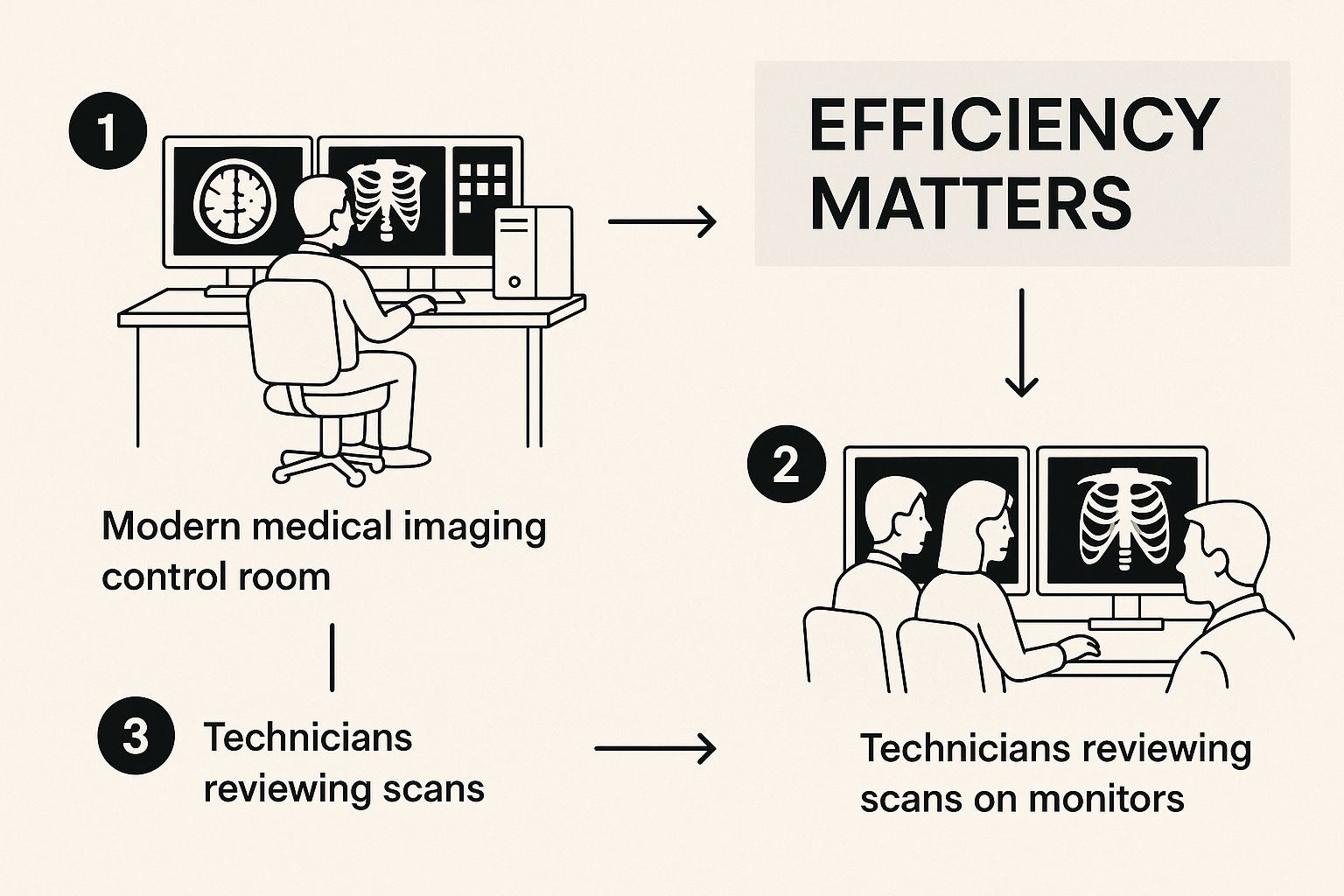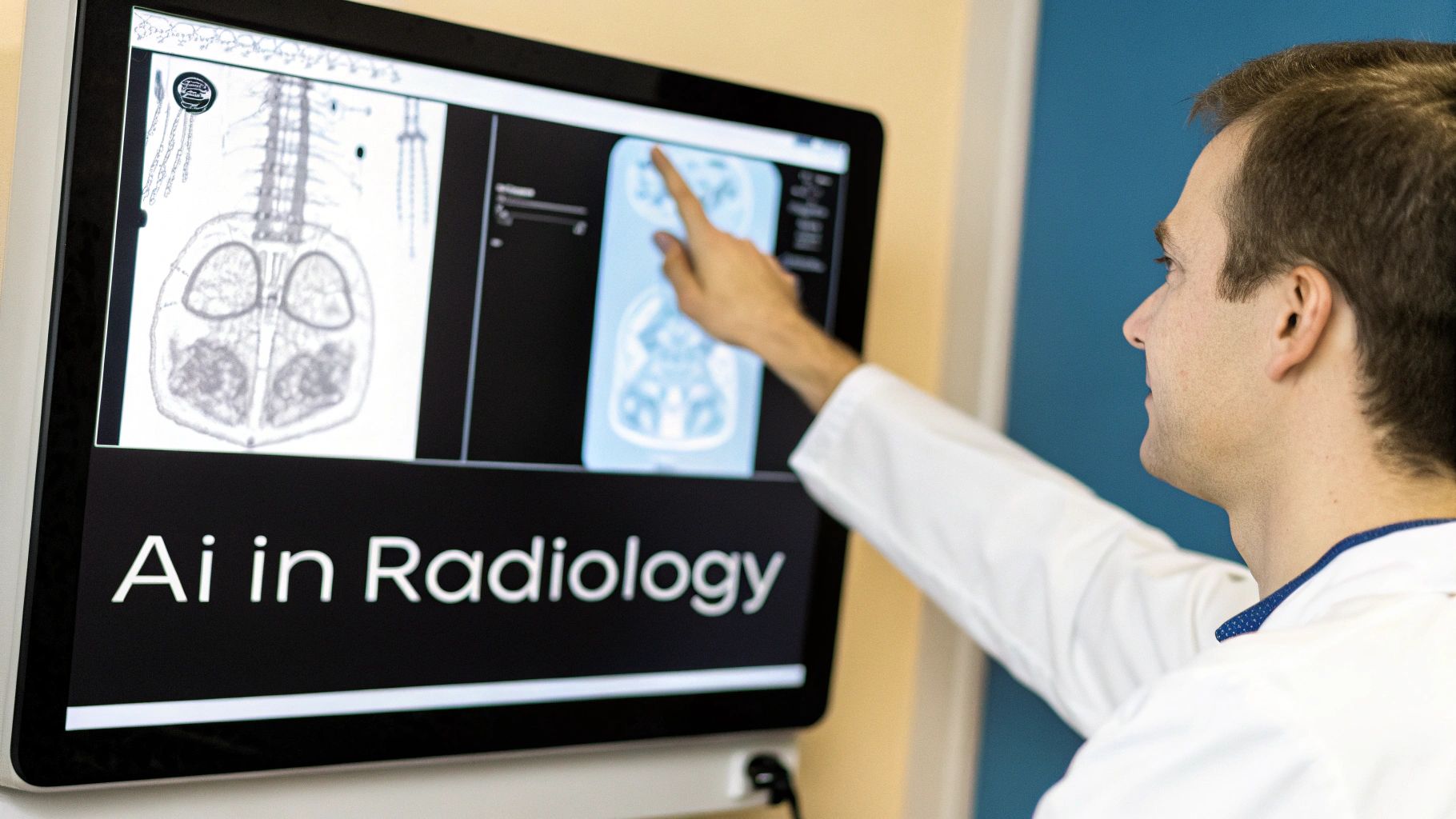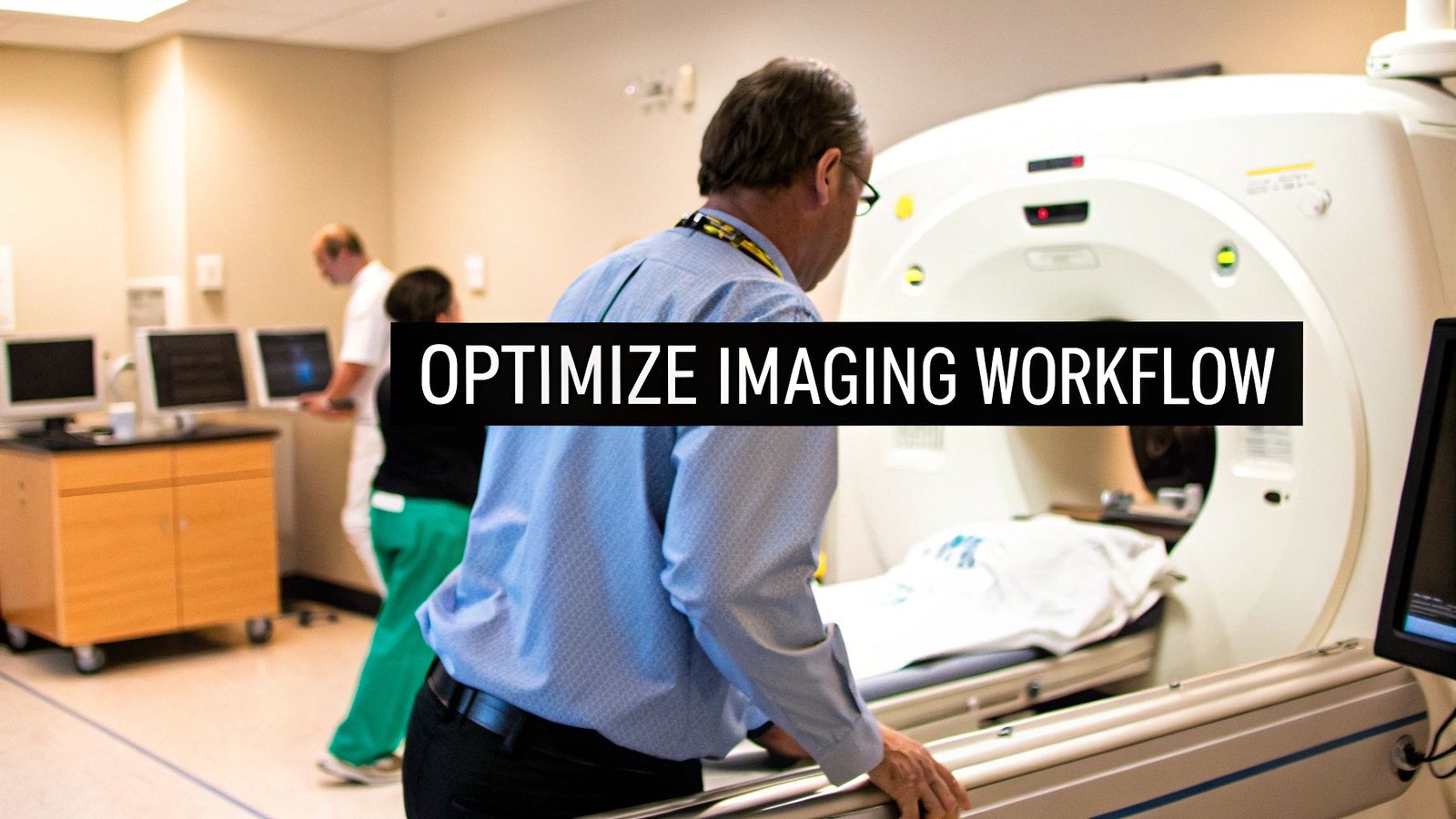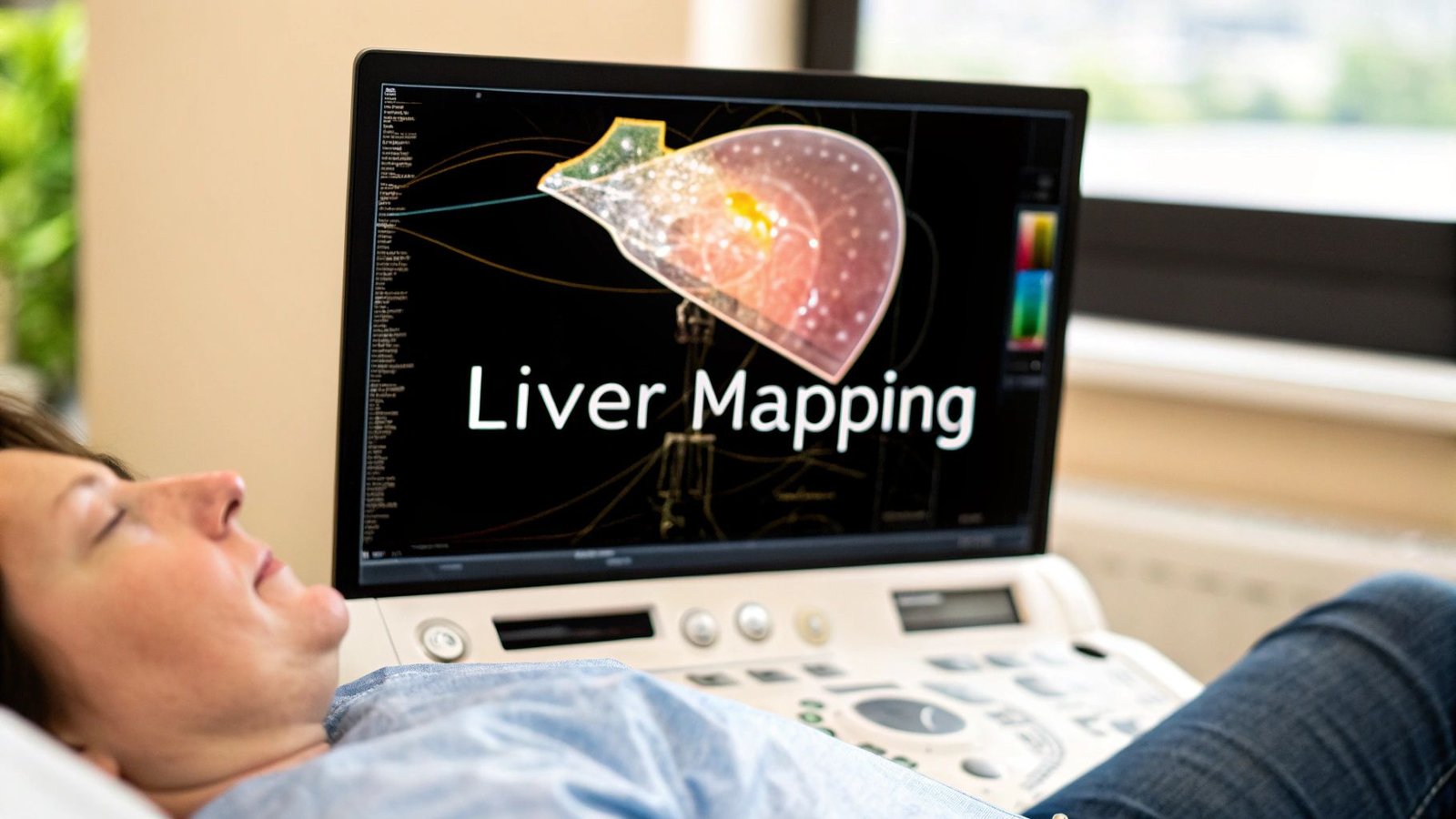To really boost operational efficiency, the focus needs to be on two key areas: automating manual tasks and optimizing workflows. It’s about cutting out the waste to get the most out of every resource. This starts by mapping out your current processes to find the real bottlenecks and then bringing in the right technology to smooth out those repetitive, time-consuming activities.
Why Operational Efficiency Is So Critical in Medical Imaging Right Now
Let's be real—the pressure in medical imaging departments is relentless. Patient volumes keep climbing, the diagnostic tools get more sophisticated, and everyone wants faster, more accurate results. In this kind of environment, being inefficient isn't just a small problem. It's a major roadblock that gets in the way of patient care and hurts the bottom line.
Every delayed report, every time someone has to re-enter data, every minute a scanner sits idle—it all has a ripple effect. These little hiccups lead to bigger problems like staff burnout and increased patient anxiety, and they can even affect the quality of care. The daily grind of dealing with workflow snags and communication breakdowns isn't just a headache; it's a huge opportunity for improvement.
This is where a clear, streamlined process becomes the backbone of a modern medical imaging operation.

The takeaway here isn't just about moving faster. It's about building a connected system where every single step, from patient check-in to final report, adds real value.
The True Cost of Inefficiency
When we talk about improving operational efficiency, it’s not just a cost-cutting exercise. The bigger picture is creating a sustainable, high-performing department that can handle the pressure. The price of sticking with inefficient systems is steep, and it's paid in more than just dollars.
- Financial Drain: Think about all the wasted technologist time, the expensive equipment sitting idle, and the administrative errors that pile up. These hit the budget hard. In fact, research shows that 74% of professionals believe automating manual tasks holds the greatest potential for process improvement.
- Compromised Patient Care: When report turnaround times lag, it can delay crucial treatment decisions. Clunky scheduling leads to longer wait times and frustrated patients, which directly impacts their experience and satisfaction.
- Staff Burnout: Nothing burns out skilled radiologists and technologists faster than saddling them with endless administrative work. An inefficient system forces brilliant people to spend less time on complex diagnoses and more time acting as clerks.
The core idea is to automate and streamline routine tasks so that clinical experts spend more of their time practicing their profession and less time attending to the administration of cases.
Learning the fundamental strategies to improve operational efficiency in your business can provide a solid foundation. Applying these proven principles within the unique context of healthcare is the first real step toward building a more resilient and effective imaging department.
Finding the Hidden Bottlenecks in Your Current Workflows
You can’t fix what you can’t see. To really boost efficiency, you have to get a clear picture of what’s happening on the ground—not just what the procedure manual claims. Most of the real problems aren't the big, obvious ones; they’re the subtle hitches and frustrating little gaps between major steps.
These are the things that quietly eat away at your team's time and energy. Think about the lag between a scan's completion and the moment a radiologist actually lays eyes on it, or the soul-crushing redundant data entry required across three different systems. These are the bottlenecks that, over time, cause major operational drag.

Uncovering Inefficiencies with a Workflow Audit
Think of a workflow audit as your department's diagnostic tool. It moves past assumptions and gives you a data-driven map of your actual processes. This isn't about pointing fingers; it's about finding opportunities to make everyone's job a little easier and more impactful.
The goal here is to trace a patient’s entire journey, from scheduling to report delivery. A fantastic way to do this is with process mapping, where you literally draw out every single action, decision, and handoff. This visual approach makes it painfully obvious where things slow down, where communication breaks, or where steps get needlessly repeated.
This hands-on method beats relying on anecdotes every time. You might discover that a specific MRI protocol consistently causes delays, or that your technologists are spending a staggering 20% of their shift on administrative work that could be automated. These are the kinds of concrete insights that lead to real change.
It's also crucial to look at how your team is using your existing digital tools. While automation is key to improving efficiency, slapping new software on top of a broken process just makes you do the wrong thing faster. A proper audit ensures you're applying technology to a solid foundation. You can discover more insights on trends that streamline operations and see why getting the process right first is so critical.
Before diving in, it's helpful to know what you're looking for. Many imaging departments run into the same kinds of snags.
Common Workflow Bottlenecks in Medical Imaging
This table highlights some of the usual suspects in medical imaging workflows and the metrics you can use to track their impact. Knowing where to look helps you focus your audit efforts for the biggest wins.
| Workflow Stage | Common Bottleneck | Key Metric to Track |
|---|---|---|
| Patient Scheduling & Intake | Manual data entry from paper forms; incomplete patient history | Time from patient arrival to scan start; form error/omission rate |
| Image Acquisition | Inconsistent scan protocols; waiting for equipment availability | Technologist rework rate; scanner utilization percentage |
| Image Distribution & Access | Slow image loading times; difficulty finding relevant prior studies | Image-to-PACS latency; radiologist "search time" per study |
| Radiologist Interpretation | Cumbersome reporting software; constant interruptions | Report Turnaround Time (TAT); average time per report |
| Reporting & Communication | Delays in report signing and distribution to referring physicians | Report sign-off time; time from sign-off to delivery |
By measuring these specific areas, you can move from vague feelings of "we're too slow" to pinpointing the exact process that needs attention.
Real-World Example: A Clinic’s Turnaround
I saw this firsthand at a mid-sized orthopedic clinic struggling with agonizingly slow report turnaround times. On paper, their workflow looked perfectly fine. But when we dug in and did a full audit, a major bottleneck emerged: radiologists were wasting several minutes on every single study manually hunting for relevant prior exams in their PACS.
By implementing a simple AI-driven tool that automatically fetched and organized relevant priors, the clinic slashed its average reporting time by over 20%. It was a small, targeted change that eliminated a huge source of friction, freeing up valuable radiologist time and getting critical results to referring physicians that much faster.
This just goes to show how a focused audit can expose a specific, solvable problem that delivers a massive impact. The key is to look at the entire chain of events, from the first phone call to the final report, and ask tough questions at every step. What tasks are repetitive? Where does information get stuck? Which steps add real value, and which are just there because "we've always done it that way"? Answering those questions is your first real step toward a more efficient, productive, and far less stressful imaging department.
Putting AI and Automation to Work in Your Department
Once you’ve zeroed in on the real bottlenecks holding your department back, it's time to bring in the right tools for the job. This is where artificial intelligence and automation stop being buzzwords and become practical solutions that can genuinely improve how medical imaging gets done. Forget the science fiction—the real value here is in augmenting your skilled professionals, not trying to replace them.
The whole point is to take the tedious, repetitive work off your team's plate. This frees them up to focus on what actually requires a human expert: complex diagnoses, nuanced interpretations, and direct patient care. Think of AI as the ultimate assistant, one that can chew through the administrative and analytical grunt work that drains so much clinical time and energy. It's about letting your experts work at the top of their game.

This is how you get strategic. By applying technology to specific friction points in your workflow, you start to see real, measurable improvements in operational efficiency.
Automating Triage and Prioritization
In any busy imaging department, every study feels urgent. AI-powered triage can bring order to that chaos by acting as a first-line filter. These algorithms scan incoming images for red-flag findings—think intracranial hemorrhage or a pulmonary embolism—and instantly push them to the top of the radiologist’s worklist.
This doesn't take the diagnosis out of the radiologist's hands. It simply gets the most critical cases in front of them first. The impact can be massive, slashing the time-to-diagnosis for life-threatening conditions from hours down to just minutes. It’s a smart way to ensure your most experienced eyes are always on the most urgent studies.
Streamlining Image Segmentation and Analysis
A surprising amount of a radiologist's day is spent on manual, click-intensive tasks like measuring tumors or segmenting organs. This is a perfect use case for AI. Automated tools can handle these measurements with incredible speed and precision, then serve up the results for the radiologist to review and confirm.
Here’s what that looks like in the real world:
- Oncology: An AI tool can automatically measure tumor volume across a series of scans, giving you rock-solid data for tracking treatment response without the manual labor.
- Cardiology: Software can calculate ejection fractions or identify calcifications in seconds, turning a time-consuming manual process into an instant data point.
- Neurology: AI can segment brain structures to quantify atrophy in dementia patients, providing objective metrics to back up clinical judgment.
By automating these tasks, you’re freeing up clinicians to focus on interpretation and clinical context—a much better use of their specialized skills.
The real power of AI in medical imaging isn't about finding a "smoking gun" abnormality that a human would miss. It's about handling the 90% of routine, time-consuming analytical work so that radiologists can dedicate their full cognitive energy to the complex 10%.
Enhancing Scheduling and Resource Management
The benefits of intelligent automation aren't just clinical. They can completely reshape the administrative side of your department, too. AI-driven scheduling systems, for instance, can analyze referral patterns, typical exam durations, and even patient no-show rates to keep your scanners humming.
These systems can intelligently slot appointments to minimize downtime, automatically reshuffle the schedule for emergency cases, and even predict future demand to help with staffing decisions. The result is higher patient throughput, better use of expensive equipment, and a much less chaotic day for your front-desk staff. The effect on morale can’t be overstated. In fact, research shows that firms integrating AI report higher employee productivity (72%) and improved job satisfaction (59%). You can dig into these productivity statistics and their impact for more detail.
Laying the Groundwork: Your Digital Transformation Strategy
Jumping into powerful new technology without a clear plan is a surefire way to end up with frustrated staff and wasted money. A real digital transformation isn't just about buying the latest AI software; it's about building a thoughtful strategy that gives equal weight to your people, your processes, and the tech itself. Think of this as your roadmap for making sure the investment pays off.
The most critical first step? Get genuine buy-in from the people on the ground floor—your clinical team. Radiologists and technologists have every right to be skeptical of changes handed down from on high. They need to understand, in practical terms, how these new systems will make their jobs better and improve patient care, not just add another complicated step to their day.
Pull them into the process from the very beginning. Put together a team with clinical champions who can actually test new software, give unfiltered feedback, and help you shape the implementation to fit the unique way your department works. When you do this, you turn potential critics into your biggest supporters.
Build a Foundation of Trust and Governance
Before you even think about going live with a new system, you have to nail down your data governance. In medical imaging, patient privacy isn't just a "best practice"—it's a fundamental legal and ethical requirement. Your strategy needs to spell out exactly how patient data will be handled, how it's anonymized for training AI, and how it’s kept secure at every single point.
This is completely non-negotiable. One mistake can shatter patient trust and leave your organization facing serious legal trouble. Make sure you're working hand-in-hand with your IT and compliance departments to ensure everything is buttoned up from day one.
A smart digital transformation happens in deliberate phases, not one big, disruptive event. The idea is to introduce change at a pace your team can handle, letting them adapt and get comfortable with new tools without throwing daily operations into chaos. This approach lowers your risk and builds momentum for what comes next.
Companies are pouring money into digital transformation. We're talking nearly $4 trillion invested globally. But here's the kicker: only about 35% of those projects actually hit their goals. That massive gap between spending and success is exactly why careful, rigorous planning is your best bet for beating the odds.
Phased Rollouts and Smooth Integration
Resist the urge to do a "big bang" launch where everything changes overnight. A phased rollout is a much smarter play. Start with one high-impact area you found during your workflow audit—maybe automating a specific measurement or using an AI triage tool for a single modality.
A pilot project like this does a few really important things:
- It proves the concept: You get to show real, tangible value in a controlled setting.
- It works out the kinks: You can find and fix integration problems on a small scale before they become massive headaches.
- It builds confidence: A win, even a small one, creates the enthusiasm you need for wider adoption.
Finally, don't ever underestimate how tricky it can be to integrate new tools with your existing EMR and PACS. An AI tool that’s a standalone system, forcing radiologists to constantly switch between screens, isn't progress—it's a step backward. Real efficiency gains come from seamless integration, where the new tech feels like a natural part of the workflow your team already knows. To really dig into modernizing your department for major efficiency gains, it's worth exploring a comprehensive guide on digital workplace transformation.
Getting Better All the Time: How to Measure What Matters
Making your department more efficient isn't a "one and done" project. It’s an ongoing process of tweaking, measuring, and improving. To know if your changes are actually working, you have to move past guesswork and start tracking the right data. This is how you prove the value of new tools and build a real culture of progress.
The first step is figuring out what to measure. You need Key Performance Indicators (KPIs) that are built for the unique world of medical imaging—not some generic metrics from a business textbook. This data will give you a clear, honest look at how your department is performing.
The Metrics That Really Count in Medical Imaging
To get a true picture of your department's health, you don’t need a hundred different data points. You just need a handful of the right ones. Focusing on these core KPIs will give you a balanced view of your speed, quality, and how well you're using your resources.
Here are the essential metrics I always recommend starting with:
-
Report Turnaround Time (TAT): This is the gold standard for a reason. Tracking the time from when a scan is finished to when the report is signed gives you a direct measurement of your entire workflow’s velocity.
-
Scanner Utilization Rate: That MRI or CT scanner is a massive investment. This number tells you how often it's actually running versus sitting empty. A low rate is a huge red flag for scheduling or workflow bottlenecks.
-
Patient Throughput: Simply put, how many patients are you getting through the door per day or per machine? This is a direct measure of your capacity and your ability to keep up with patient demand.
-
Diagnostic Error or Discrepancy Rates: Speed is great, but not at the cost of accuracy. Keeping an eye on the rate of discrepancies between initial and final reads is non-negotiable for maintaining quality of care.
Turning Numbers into Action
Collecting data is easy. The hard part is turning it into something you can actually use.
The best way I've seen this done is by setting up a simple dashboard. It doesn't need to be fancy—just a clear, visual way to see your KPIs at a glance. When the whole team can see how they're performing in real time, it creates an immediate feedback loop.
The real magic happens when you connect a change to a result. When your team sees that a new AI tool directly led to a 15% drop in TAT, it generates incredible buy-in for what comes next.
This kind of transparency is what builds a culture of continuous improvement. When your team understands the goals and sees the data, they stop being passive observers and become active problem-solvers.
Encourage them to bring you ideas based on what they're seeing on the ground. Your technologists and radiologists are the ones living the workflow every day, and they often have the most practical suggestions. This creates a powerful cycle: the data shows you a problem, the team collaborates on a fix, and the KPIs prove it worked.
Got Questions About Operational Efficiency? We Have Answers.
When it comes to improving how a clinic runs, there are always practical questions that pop up. Thinking through these ahead of time can make all the difference, helping your team feel confident and prepared for what’s next. Let's tackle some of the most common ones I hear from practices just getting started.
So, Where Do We Even Begin?
The best place to start is with a workflow audit. It sounds formal, but it’s really just about getting an honest, clear-eyed look at how things actually work right now, before you even think about new software or processes.
A great way to do this is with process mapping. Literally trace a patient’s journey from the moment they book an appointment to when their report is finalized and signed. This will show you exactly where the snags are. You’ll move past assumptions and see the real bottlenecks—maybe it’s a manual data entry step that takes forever or a communication breakdown between techs and radiologists.
Focusing on these specific, high-impact spots first will give you the quickest wins and build momentum for the bigger changes down the road.
How Can We Get Our Clinical Staff to Buy In?
This is probably the most critical piece of the puzzle. Getting your team on board is everything. The key is to show them that new technology isn't here to replace them, but to act as a hyper-efficient assistant. It’s about taking the tedious, repetitive tasks off their plate so they can focus on the complex work they were trained for.
Here’s what works: involve them from day one. Let your radiologists and technologists help choose and test the tools.
Run a small pilot program. Let them see for themselves how an AI tool can automate mind-numbing measurements or streamline report formatting. When they experience firsthand how it reduces their administrative burden and helps prevent burnout, you’ll see skepticism melt away.
The most powerful tools you have for overcoming resistance are open communication and hands-on experience. Don't just tell them how it will help—show them. Let them feel how these changes can make their demanding jobs easier and more centered on patient care.
What Metrics Actually Matter?
You could track a million different things, but that’s a surefire way to get lost in the data. I always advise starting with just a few core metrics that tell you the most important parts of the story.
For medical imaging, these are the heavy hitters:
- Report Turnaround Time (TAT): This is the classic. How long does it take from the end of the scan to a signed-off report? It’s a direct measure of your workflow’s speed.
- Scanner Utilization Rate: Your imaging equipment is a massive investment. This metric shows you if you're getting the most out of it and can highlight issues with scheduling or patient flow.
- Patient Throughput: Simply, how many patients are you able to see in a day? This gives you a clear sense of your department’s overall capacity.
And don’t forget to keep an eye on your Diagnostic Agreement Rates. You need to be sure that your drive for speed isn't compromising the quality of care. Nailing these core metrics gives you a clear, actionable dashboard of your performance.
Ready to bring intelligent automation to your medical imaging workflows? PYCAD specializes in creating and deploying AI solutions that enhance diagnostic accuracy and boost operational efficiency. Discover how our expertise can meet your specific needs at https://pycad.co.






